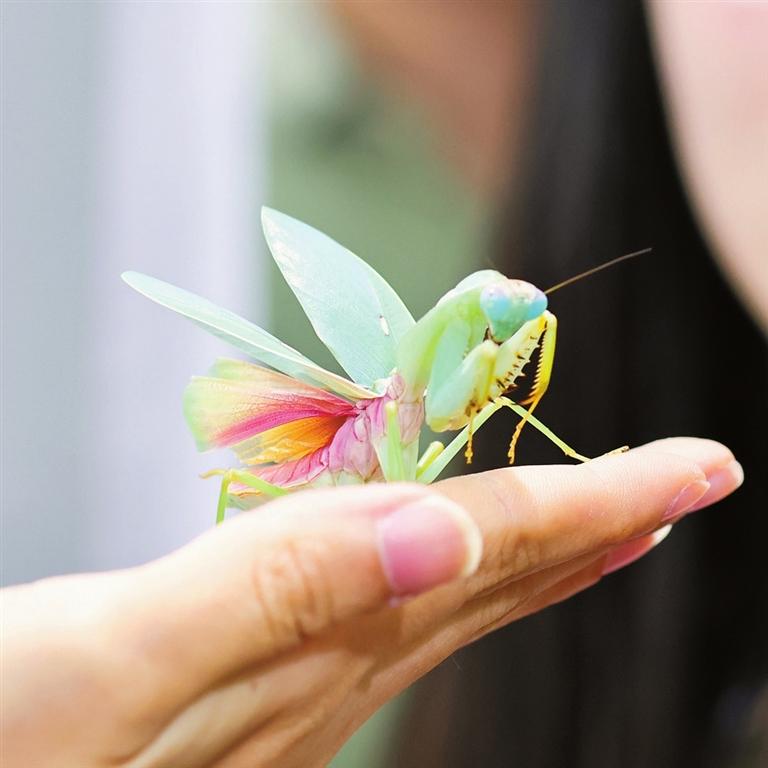



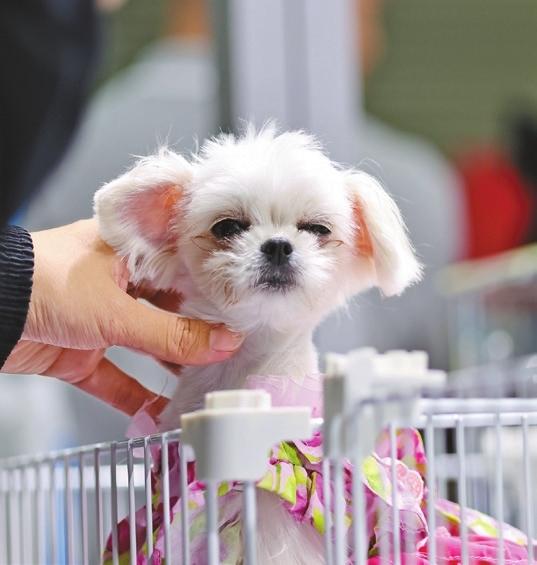
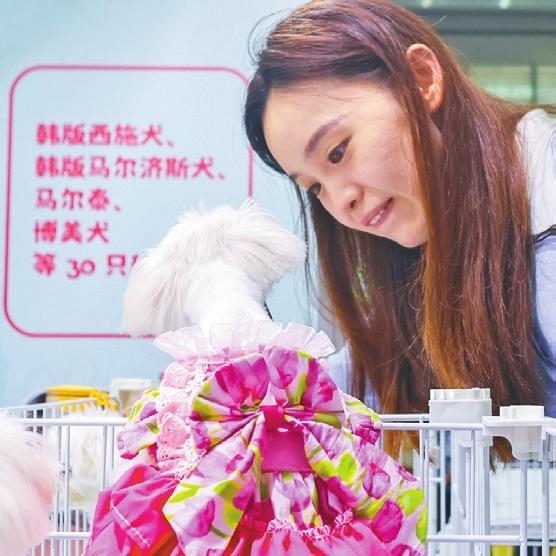

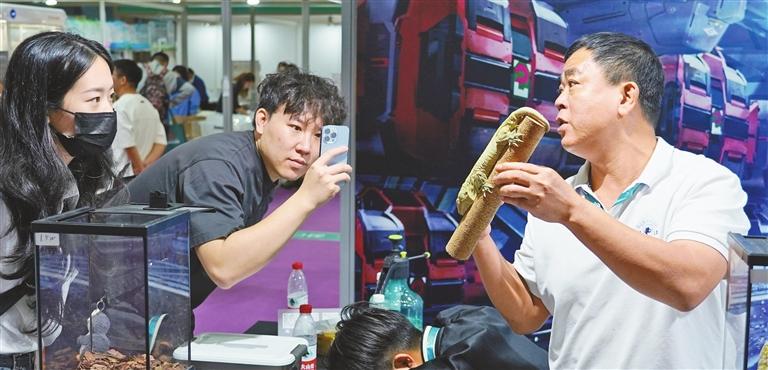
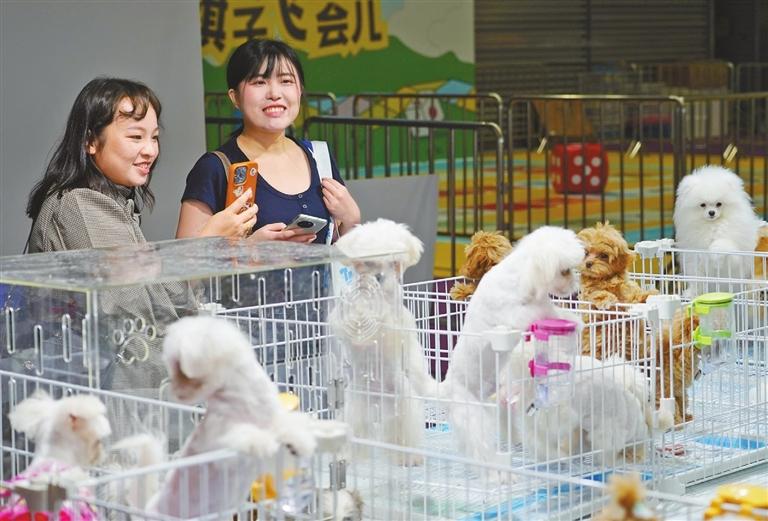
Wang Jingli wangjingli0715@163.com DOGS of all shapes and sizes paraded through the event grounds, eliciting smiles and adoring glances from attendees at the 12th Shenzhen International Pet Supplies Exhibition and Global Pet Cross-border E-Commerce Fair, which was held from Oct. 25 to 27 at the Shenzhen Convention and Exhibition Center in Futian District. The event, which attracted over 80,000 visitors, brought together more than 300 exhibitors from home and abroad and featured over 3,000 well-known brands, covering the entire industrial chain of pet food, supplies, and medical care to create a comprehensive exhibition and trade cooperation platform. Reflecting the growing trend of the small-pet market, this year’s exhibition introduced exhibitors showcasing small pets like birds and reptiles. Pet food and beyond According to market consultancy iiMedia Research, China’s pet food market reached a scale of 190 billion yuan (US$26.6 billion) in 2023 and is expected to grow to 267 billion yuan by 2025. A Shenzhen-based agency representing German pet food brand Bewital in China told Shenzhen Daily at the fair that the company saw approximately a 30% increase in annual sales in China. With competition intensifying and consumer preferences becoming more sophisticated, many pet food suppliers are striving to differentiate themselves through a commitment to high-quality products rather than engaging in price wars. Baked dog food was displayed by many exhibitors. The method of slow and careful baking is said to help retain the food’s nutritional value, providing a wholesome and balanced meal for dogs. An exhibition attendee surnamed Wang, who has a Bichon and a Schnauzer, stated that although baked dog food is slightly more expensive, she prefers to offer healthier options to her two “kids.” Since pets are often regarded as family members, pet communication has emerged as a new sector. Pet communicators not only facilitate a deeper emotional connection between pet owners and their pets, but also help owners interpret messages their pets are trying to convey. With this method, many concerns or issues can be addressed. A team from Taiwan was invited to offer free pet communication services by exhibition organizers for the first time, and their booth attracted many visitors. Interested pet owners were required to bring their pets and engage in face-to-face discussions with the communicators. All consultation slots were fully booked on the fair's opening day. A pet owner surnamed Chen mentioned that she typically learns training and communication tips from social media platforms like Douyin. “Although pet communication may sound a bit metaphysical, I’m willing to spend money for peace of mind — just like parents try various solutions when their children cry without a clear reason. Additionally, the communicator provides emotional support to help alleviate my concerns — why not?” she commented. “However, I feel there’s a lack of regulatory standards, so it’s important to exercise caution when paying for these services,” Chen added. Diversification of firms In the first 10 months of this year, the number of newly registered enterprises related to the pet industry in China has reached 945,000, according to Economic Information Daily. The booming pet economy has attracted businesses from various sectors in recent years. For instance, Shenzhen Xuliyun Electronic Technology Co. unveiled its AI-powered automatic pet feeding machine at a pet exhibition. Originally a producer of surveillance cameras, the company identified a business opportunity arising from evolving consumer demands and the growing number of pets in China. To meet a market gap, the company integrated its surveillance camera with a feeding machine. The machine, which has a camera on top, can be remotely controlled via a self-developed mobile application. Pet owners can set customized feeding schedules, entertain their pets with laser pointers, interact through sound and video via the camera, and even generate AI-assisted videos. A representative from Xuliyun said the company received inquiries about the product from foreign buyers during the exhibition and is confident that the product will perform well on the market. The feeding machine will officially go on sale after the exhibition The pet industry has also attracted Shenzhen-based design firm Odian Design, which showcased a unique series of pet tools at the fair, including an innovative feeding bowl with a double-layer structure — snacks below and dog food above. The bowl features air holes that entice pets to eat food they might otherwise dislike, such as medicine. Additionally, its upper partition keeps different foods or water separated and helps prevent spills. SZ’s support for pet economy Currently, Shenzhen is home to over 88,000 pet-related companies, and the annual turnover of the pet services market is approximately 3 billion yuan, according to public data. In July, Shenzhen’s market supervision authority unveiled a work plan aimed at promoting the high-quality development of the pet industry and set a goal of surpassing 10 billion yuan in operating income from pet-related industries by 2026. This year, districts like Luohu, Futian, and Bao’an have taken actions to support the pet economy and drive development of the entire industrial chain. Luohu offers up to 100 million yuan in support to attract top pet companies, along with grants of up to 150,000 yuan for renowned pet brands that open “first stores.” Futian encourages pet-related firms to develop new quality productive forces with up to 3 million yuan of support. To address the shortage of qualified professionals in the pet sector, the district offers financial incentives to key firms or institutions that establish internship programs for undergraduate students. In August, Bao’an launched Shenzhen’s first district-level pet service industry association, which aims to create a platform where members of the district’s pet industry can exchange information and share resources. The platform is expected to act as a bridge between the government and enterprises and promote rapid development in the pet service sector. Additionally, Shenzhen is increasingly focused on creating pet-friendly spaces and services. Current data indicate there are over 10 pet-friendly outdoor parks, more than 50 pet-friendly shopping malls, and over 1,000 pet-friendly dining outlets in the city. In May, the Shenzhen Bao’an International Airport opened a waiting lounge for pets and their owners, the first of its kind in China. Additionally, the city’s first pet-friendly bus route, H239, was launched in April. | 
